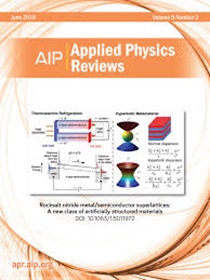Magnetic skyrmion: from fundamental physics to pioneering applications
IF 11.9
1区 物理与天体物理
Q1 PHYSICS, APPLIED
引用次数: 0
Abstract
Skyrmionic devices exhibit energy-efficient and high-integration data storage and computing capabilities due to their small size, topological protection, and low drive current requirements. So, to realize these devices, an extensive study, from fundamental physics to practical applications, becomes essential. In this article, we present an exhaustive review of the advancements in understanding the fundamental physics behind magnetic skyrmions and the novel data storage and computing technologies based on them. We begin with an in-depth discussion of fundamental concepts such as topological protection, stability, statics, and dynamics essential for understanding skyrmions, henceforth the foundation of skyrmion technologies. For the realization of CMOS-compatible skyrmion functional devices, the writing and reading of the skyrmions are crucial. We discuss the developments in different writing schemes such as STT, SOT, and VCMA. The reading of skyrmions is predominantly achieved via two mechanisms: the magnetoresistive tunnel junction TMR effect and topological resistivity. So, a thorough investigation into the skyrmion Hall effect, topological properties, and emergent fields is also provided, concluding the discussion on skyrmion reading developments. Based on the writing and reading schemes, we discuss the applications of the skyrmions in conventional logic, unconventional logic, memory applications, and neuromorphic computing, including a model of a skyrmion-based SNN architecture achieving over 90% accuracy on MNIST and fashion-MNIST datasets. Furthermore, we outline the potential of skyrmion-hosting Majorana zero modes in emerging topological quantum computation and helicity-dependent skyrmion qubits.磁skyrmion:从基础物理到开创性应用
由于尺寸小、拓扑保护和低驱动电流要求,Skyrmionic设备具有高能效和高集成度的数据存储和计算能力。因此,要实现这些装置,从基础物理到实际应用的广泛研究变得至关重要。在这篇文章中,我们详尽地回顾了在理解磁天空背后的基本物理以及基于它们的新型数据存储和计算技术方面的进展。我们从深入讨论基本概念开始,如拓扑保护、稳定性、静力学和动力学,这些概念对于理解skyrmions至关重要,因此是skyrmions技术的基础。为了实现与cmos兼容的skyrmion功能器件,skyrmion的写入和读取是至关重要的。我们讨论了STT、SOT和VCMA等不同书写方案的发展。skyrmins的读取主要通过两种机制实现:磁阻隧道结TMR效应和拓扑电阻率。因此,本文还对斯基米恩霍尔效应、拓扑性质和新兴领域进行了深入的研究,并对斯基米恩阅读的发展进行了讨论。基于书写和读取方案,我们讨论了skyrmions在传统逻辑、非常规逻辑、存储应用和神经形态计算中的应用,包括基于skyrmions的SNN架构模型,该模型在MNIST和时尚MNIST数据集上实现了90%以上的准确率。此外,我们概述了承载skyrmion的Majorana零模式在新兴拓扑量子计算和依赖于螺旋度的skyrmion量子位中的潜力。
本文章由计算机程序翻译,如有差异,请以英文原文为准。
求助全文
约1分钟内获得全文
求助全文
来源期刊

Applied physics reviews
PHYSICS, APPLIED-
CiteScore
22.50
自引率
2.00%
发文量
113
审稿时长
2 months
期刊介绍:
Applied Physics Reviews (APR) is a journal featuring articles on critical topics in experimental or theoretical research in applied physics and applications of physics to other scientific and engineering branches. The publication includes two main types of articles:
Original Research: These articles report on high-quality, novel research studies that are of significant interest to the applied physics community.
Reviews: Review articles in APR can either be authoritative and comprehensive assessments of established areas of applied physics or short, timely reviews of recent advances in established fields or emerging areas of applied physics.
 求助内容:
求助内容: 应助结果提醒方式:
应助结果提醒方式:


